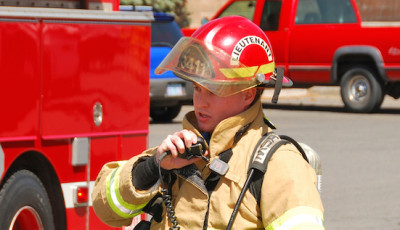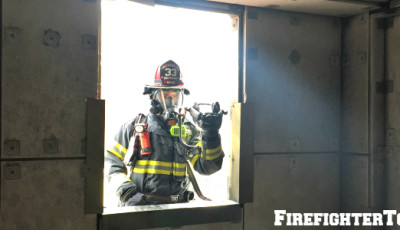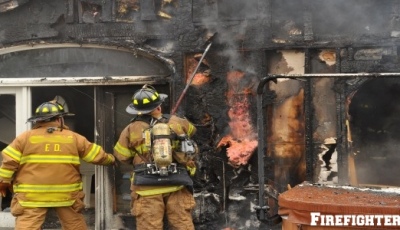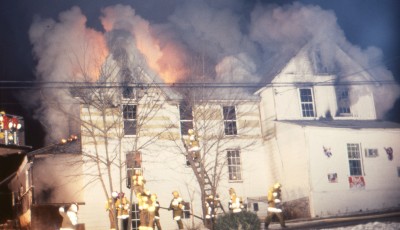Tactical Ventilation – What is It?
By: Michael R. Rehfeld – FireFighterToolbox.com
Over the years, fire suppression operations and fire ground tactics have focused primarily on putting the wet stuff on the red stuff. Appropriately so, one would guess.
In reality the fire only goes out in one of two ways, it either consumes all the available fuel or it is suppressed into submission by overwhelming force with water or other suppressing agents.
So, how and where, does this relatively new theory of “Tactical Ventilation” fit into that equation? This tool, when properly executed, is essential to accomplishing the goal of suppression and most importantly, in the end, survival.
How many of you have had the situation occur when a vent point was created behind you as you are advancing and you were overrun by fire conditions? That was poor tactical ventilation!
On the other hand, how many of you have had the fortune of a vent point opposite of your advance? You were able to move with less heat and smoke and easily advance on the fire. That is proper tactical ventilation.
As most of you know, we as firefighting warriors function under the premise that whatever needs to be done to accomplish goals or objectives on the fireground we can accomplish with force (or in my world a truck company).
Just look at a simplistic view of a very complicated process called structural firefighting. As some of us have learned the hard way we must have a well-coordinated plan of attack and in order for that plan to be rapidly successful a host of tactics must be implemented.
Let’s focus on one aspect of that coordinated plan of attack, in particular something called tactical ventilation must occur with a purpose and plan. The three tactical ventilation motives are:
• Vent for Life
• Vent for Fire
• Vent for Safety
Plain and simple, the function of ventilation is the movement of air from a high pressure to a low pressure. This occurs when pressure (heat) is created within the structure and a vent point is created that is of less pressure (heat) normally the outside air.
The tactical part of that equation is us. How we create that vent point, when we create that vent point and how we create that vent point greatly impacts the fire dynamics occurring within the structure. As fire suppression guys (engine company) you must depend on a proper tactical vent plan to survive and accomplish your goal of overwhelming the fire with water.
The importance of understanding what we are trying to accomplish with “venting” a building cannot be overstated. In my next segment we will focus on the dos and the don’ts of venting. Until then be safe and remember PTB (Protect the Brothers)!











Fire goes out in one of three ways. Remove the fuel, remove the oxygen, or remove the heat. ie water, foam, chemicals, etc.
Jim,
Not sure what you are getting at?? Are you saying ventilation is unnecessary in fire attack??
Mike
I don’t think anyone would discredit the importance of ventilation but point being a ventilation starved fire can exist making it just as decayed as a fuel deprived fire.
Considering the North American roof venting tactics and the amount of LODD’s caused by this practise….which is rarely used by most other countries around the world, its maybe time you guys looked at new techniques.
I agree with Dave…with these light weight roof trusses horizontal ventilation is a good option…I have a hard time putting personnel on a roof unless it’s heavy timber const. As I do my walk around I take out a window on leeward side…then try to make entry on windward side. LOL we only have 3 man engines, which is 2 more than when I started in 1982.
Dwight, thanks for the comment. Your process of venting during your 360 is sound. The only suggestion I have is to wait to vent until the hoseline is in place at the attack position. This falls more in line with the UL & NIST testing and best practices for preventing injury to our folks in rapid fire growth conditions. Just a thought!
As for vertical ventilation, Dave’s and your concerns are valid. My experience has shown me that vertical ventilation if it is a tactical choice must occur early in the attack faze. If the fire already has possession of the space directly under the roof, then your view is the correct choice. Either way, experience and knowing the conditions are the key.
Dave, I must disagree. The number of LODD’s associated with vertical ventilation in the past 20 years is very low compared to other fire ground tasks. The key to vertical ventilations effectiveness is early ventilation, not an after thought. If the fire has possession of the space directly under the roof, than the risk may very well out way the benefit. If the fire is not directly under the roof, then this tactic is invaluable. I wish you had ridden with my Truck crew so you could see this in action.
Thanks for the dialogue!!Be safe!
Hi Mike,
Great information. The picture you have posted with this particular article involved my department. Before we took out those windows we had a portable monitor set up at each corner of the building ready to pound the fire. We also brought our aerial platform in low and directed a solid stream up into the ceiling area. All three streams hit at the same time. The conditions at the time indicated that the fire was still confined to the occupant space ( book store) and had not gotten under the roof. While vertical venting was still an option, fire conditions and manpower issues led us to what you see in the photo. Oh…the results were a complete knock down in less then 3 minutes. Keep information flowing.
Stay Safe,
Bob